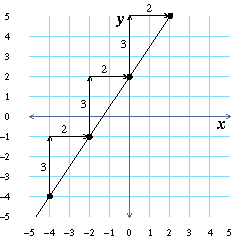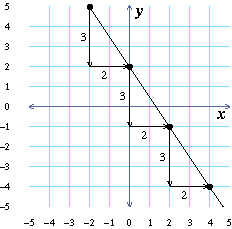What do you think the graph of $4x+2y=4$ looks like? In this lesson you will learn about the
graph of this and other similar equations.
The slope of a line is a measurement of how steep it is. Use the figures
below to help remind you about how to measure the slope of a line. The
first line graphed below has slope $$3/2$$, while the second one has slope $$-3/2$$.


Look at the grid to the left to answer the following questions.
|
What is the slope of $4x+2y=4$?
| |
|
What is the $y$-intercept of $4x+2y=4$ (where does it
cross the $y$-axis)?
| |
|
What is the $x$-intercept of $4x+2y=4$ (where does it
cross the $x$-axis)?
| |
The effects of A, B, and C
To the left is the graph of $Ax+By=C$.
You are looking at the graph of $4x+2y=4$
(because $A=4$, $B=2$, $C=4$). Use the sliders to change the values of $A$, $B$, and $C$ and
notice how each affects the shape and position of the graph of
$Ax+By=C$.
Each row of the following table has a question about how the graph changes when you change
$A$, $B$, or $C$. Answer the question for each of the three variables.
| When $A$ changes | When $B$ changes | When $C$ changes
|
|---|
| Does the graph of the equation remain a line?
|
|
|
|
| Does the $x$-intercept of the graph change?
|
|
|
|
| Does the $y$-intercept of the graph change?
|
|
|
|
| Does the slope of the graph change?
|
|
|
|
The form $Ax+By=C$, where $A$, $B$, and $C$ are
constants, is called the standard form for
an equation for a line.
Each row of the table below gives an equation for a line in standard form.
Using the sliders, change the values of $A$, $B$, and $C$, and complete this table. In each
case, find the slope of the line by looking at the grid to the left.
|
Using the pattern in the table, what do you think the slope of
$2x+5y=40$ is?
| |
The slopes you have found suggest that:
The slope of the line $Ax+By=C$ is $$-A/B$$.
Converting from standard form to slope-intercept form
In the last question, you found the slopes of lines by looking at their graphs. If you want
to find the slope of a line algebraically, by using its
equation, you can convert that equation into slope-intercept form.
For example, we can write the equation $4x+2y=4$ in slope-intercept form as follows:
$$
\cl"tight ma-join-align"{\table
\text"Standard form: ", , 4x+, 2y, =, , 4;
\text"Subtract" \: 4x \: \text"from both sides: ", -4x+, 4x+, 2y, =, -4x+, 4;
, , , 2y, =, -4x+, 4;
\text"Multiply both sides by" \: 1/2 \text": ", , , 1/2(2y), =, \colspan 2{1/2(-4x+4)};
\text"Distribute: ", , , y, =, 1/2(-4x)+, 1/2(4);
\text"Slope-intercept form: ", , , y, =, -2x+, 2
}
$$
Each row of the table has an equation in standard form. Write that
equation in slope-intercept form.
Finding the $x$- and $y$- intercepts of a line in standard form
The $y$-intercept of a line is the point on that line where $x=0$, and the $x$-intercept is
the point where $y=0$. You can use this to find the intercepts of lines algebraically.
Algebraically find the $y$-intercept of each line in the table below.
| equation for
the line | set $x=0$ | $y$-intercept
|
|---|